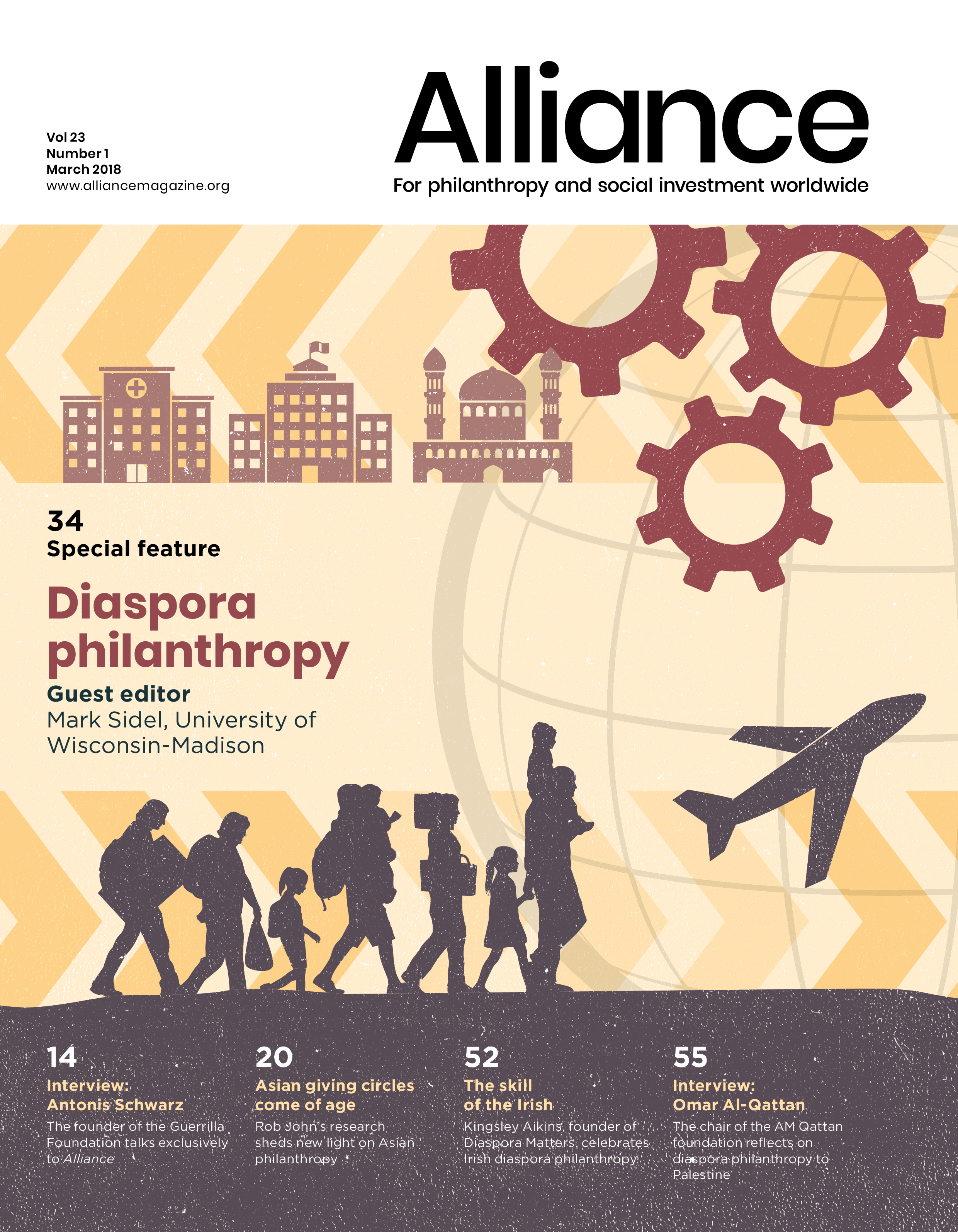Recent studies from the US, Europe and Asia have found a surge in the growth of giving circle membership.
Not only that, our latest research from Asia supports those studies in suggesting that participation in a giving circle can help donors become more generous and strategic with their money and time, and positively change their attitude towards non-profits and philanthropy.
Contemporary giving circles – self-organized groups of individuals who pool their donations and jointly decide which non-profits to fund – have their roots in much older collective philanthropy initiatives, such as Victorian soup kitchens in the UK and Rotary clubs in the US. Over the last decade they have been enjoying strong growth.
The number of giving circles in the US has tripled since 2007 and they have donated up to $1.2 billion, according to the Collective Giving Research Group.
More than a third of people who responded to a survey of Australian donors published in the Giving Australia 2016 report said they gave collectively.
Our recent study, conducted in 2017, confirms this and charts a significant increase in Asian giving circles.
We estimate that since 2014 the number of Asian circles has almost doubled to 66, across nine countries. The largest growth is in Australia, from nine in 2014 to 21 today, created by the expansion of transplanted networks and the formation of new indigenous circles.
Growth providing a stimulus to study
As a result, studying giving circles is a new and important area of applied research. Before outlining in detail the findings of our 2017 study, it is important to offer some context.
Studies by Jessica Bearman and Angela Eikenberry[1] laid the groundwork for our understanding of the characteristics of collective giving and how participating changed the behaviour and attitudes of donors.
They found that when individuals joined a giving circle the added opportunities for learning about giving led to many donating more generously and strategically.
When individuals joined a giving circle the added opportunities for learning about giving led to many donating more generously and strategically.
Members also increased their knowledge of social needs in their community and the work of non-profits, often leading to increased volunteering of time and skills.
Researchers found that the majority of giving circles were independent but hosted by another organization, often a community foundation, which provided strategic partnership or administrative support.
In an earlier study, carried out in 2014 (‘Virtuous Circles: the growth of collective philanthropy in Asia’, Alliance 19, No 1), we identified 35 giving circles in eight countries, which we categorised as two kinds – those that had been transplanted into Asia from existing circles or networks in the US or UK, and indigenous initiatives.
Transplanted circles, even those operating like a franchise, needed strong local leadership and displayed autonomy in shaping their organization to best serve local circumstances.
The founding members of Social Venture Partners (SVP) Melbourne, for example, departed from standard US practice to create a dual fund structure that gave the chapter flexibility to donate grants to charities and provide equity and loans to the strong local social business sector.
The study also showed that giving circles in Asia, whether transplanted or indigenous, covered a wide spectrum of donation size by members into the pooled fund.
Focus India Forum, a circle of 250 expatriate Indians in Singapore, asked its members to contribute just $16 each month, although many topped up the fee from salary bonuses.
At the other end of the spectrum, the ten or so members of Dasra Giving Circles in India each committed $20,000 annually for the three-year lifetime of the circle. The bulk of giving circles studied, however, encouraged members to donate amounts between these two extremes – typically several thousand dollars annually.
The 2017 study
In our most recent study[2] carried out in the first half of 2017, we surveyed the members of 38 giving circles located in eight Asian countries. The growing popularity of collective giving in the region prompted us to explore if joining a circle enhanced an individual’s knowledge and practice of philanthropy, as observed in earlier research from the US and UK.
Our survey attracted responses from 188 individuals in 38 giving circles in China, Hong Kong, India, Japan, New Zealand, Australia, Singapore, South Korea and Vietnam. Eighty-three per cent of them had been active in their giving circle for at least a year, with nearly a half giving collectively for three years.
Two-thirds of members valued the social aspects of giving collectively – meeting new people, sharing experiences, dinners and social events – with nearly half spending between one and ten hours a month on circle activities.
The majority (63 per cent) had been recruited into the circle by friends or colleagues who were already members. Such organic, peer-led growth, based on trust, shared networks and interests is important during the early years of a giving circle community.
Two-thirds of members valued the social aspects of giving collectively – meeting new people, sharing experiences, dinners and social events – with nearly half spending between one and ten hours a month on circle activities.
Some of this time is spent by members who volunteer to evaluate new projects or offer advice to the non-profits the group has chosen to support. Over half of this volunteering to non-profits was described as ‘skilled’ in the survey responses, for example offering advice on strategy, fundraising or operations.
While most circles work within the geographic community of their members, the Australian circle PiCCA (Partners in International Collaborative Community Aid) is unusual in choosing to support development work outside the country, with its members travelling internationally to evaluate and support projects.
Skilled peers leads to more discerning giving
The relatively high level of skilled engagement by donors is key to the way giving circles provide educational opportunities for their members – learning to do philanthropy better by working with non-profits and alongside other members.
Many circles also host educational events to complement learning by doing.
The majority of surveyed members felt better informed about social issues and the charity sector (86 per cent) and more positive about the work of non-profits (87 per cent).
Participating in a giving circle appears to be a powerful way for individuals to make progress in their giving journey, offering experiences and a level of satisfaction more usually associated with the institutional philanthropy of foundations or family trusts.
One respondent’s comment typifies this: ‘Being a member of a giving circle allowed me greater exposure and insight into some of the issues affecting women and children in particular, and how NGOs work to combat these challenges.’
More engagement, more giving
Being better informed and engaged donors results in over half of members increasing their level of charitable donations generally (55 per cent), and viewing their giving to be more discerning, strategic and focused on outcomes (58 per cent). These are interesting changes in the giving practices of individuals and broadly reflect comparable studies in the US, UK and Australia.
Participating in a giving circle appears to be a powerful way for individuals to make progress in their giving journey, offering experiences and a level of satisfaction more usually associated with the institutional philanthropy of foundations or family trusts.
As one respondent told us: ‘Being in a giving circle has made me realize that by working with like-minded people we can help bring about change.’ Many of the circles we interviewed also multiplied their social impact by collaborating with community or corporate foundations and other circles. SVP India has taken collaboration a step further by convening a ‘collective impact’ initiative involving its chapters and other stakeholders.
Giving circles are growing in popularity around the world.
Whether they will be what the Denver Post calls one of the ‘ways the world of philanthropy could change in 2018’ remains to be seen, but we do know from research in America, Europe and Asia that they will be part of shaping a new generation of donors.
| PiCCA, Australia |
|---|
| PiCCA was founded in 2014 to improve health, education and income in disadvantaged communities outside Australia. The 21 members have raised $42,000 to support NGOs in Swaziland, Sri Lanka, Nepal and Papua New Guinea.
Circle members pay their own way when volunteering to assess new projects or support existing ones. The site visit team may spend up to two weeks as guests of a community group or NGO, offering advice as well as assessing suitability for funding. PiCCA strives for a high degree of participation and transparency when building a relationship with local groups, and is realistic about the high degree of risk involved in long-distance projects. On return to Australia the members present a detailed report to the whole group so a funding decision can be agreed by all. |
| SVP India |
|---|
| The Indian chapter of Social Venture Partners was launched in Bangalore in 2012 by a former chairman of Microsoft India, who envisioned impact at scale: ‘You start small and insignificant, but particularly after my experience at Microsoft, I knew we had to plan for scale – to be one of the largest and most influential organizations on the Indian philanthropy landscape.’
SVP India grew to include four city chapters by 2017 and has mobilized 180 business leaders to raise $460,000 and offer 17,000 volunteer hours to 18 non-profits. The chapters set their own priorities for what to fund locally and have agreed to collaborate nationally on projects to create a million sustainable jobs over the next five years. To this end, in 2017 the chapters convened a ‘collective impact’ conference in New Delhi. The Million Jobs Mission invited private foundations, government representatives, corporations and scholars to collaborate with SVP chapters and the non-profits they support. |
Rob John is an associate of the Centre for the Study of Philanthropy and Public Good, University of St. Andrews
Email rob.john@oba.co.uk
Footnotes
- ^ Much of this pioneering research is summed up in Giving Circles: Philanthropy, Voluntary Association and Democracy, Angela Eikenberry, Indiana University Press, 2009.
- ^ Circles of Influence: The Impact of Giving Circles in Asia, Rob John, NUS Business School, Singapore, 2017. https://robjohn.academia.edu/research







Comments (0)